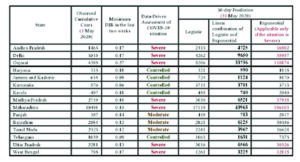GUWAHATI, MAY 11
Researchers from the Indian Institute of Technology Guwahati, India, and the Duke-NUS Medical School, Singapore, have used data science models to analyse and predict the total number of infected people for different States in India in the next 30 days. A report solely based on anyone model can potentially mislead us. In an attempt to guard against this possibility, they have considered the exponential, the logistic, and the Susceptible Infectious Susceptible (SIS) models, along with the model-free daily infection-rate (DIR) using open-source data. They have interpreted the results jointly from all models rather than individually, a press release issued here on Monday said.
The data-driven assessment is carried out by Palash Ghosh, Assistant Professor, Department of Mathematics, IIT Guwahati, and his Ph.D. scholar, Rik Ghosh, in collaboration with Dr. Bibhas Chakraborty, Associate Professor, Duke-NUS Medical School, Singapore. Their report is based on the growth of active cases in recent times, along with the daily infection-rate (DIR) values for each State. They label a State as severe if a non-decreasing trend in DIR values is observed over the last two weeks along with a near exponential growth in active infected cases; as moderate if an almost decreasing trend in DIR values is observed over the last two weeks along with neither increasing nor decreasing growth in active infected cases; and as controlled if a decreasing trend in the last two weeks’ DIR values is observed along with a decreasing growth in active infected cases (See Table: restricting to only those States with enough data for prediction).

In their analysis, the logistic model under-predicts the next 30-day prediction, whereas the exponential model over-predicts the same, reflecting the worst-case scenario. They argued that, despite the nation-wide lockdown, people are still out of home for essential businesses, which can contribute to the spreading of the virus. The maximum value of DIR in the last two weeks can capture how severely the COVID-19 is spreading in recent times. Note that the DIR value of 0.10 cannot be interpreted in a similar way for two different States, say, with 500 and 5000 active cases, respectively. For the first State, we see 500 x 0.10 = 50 new cases and for the second State, we observe 5000 x 0.10 = 500 new cases.
In an attempt to capture these various subtleties in a realistic prediction, they propose a combination of the logistic and the exponential predictions using the maximum value of DIR over the last two weeks as a weighting factor. Given the situation in entire India, they recommend this composite prediction to be used for assessment purposes for each State. States that are in severe category need to do much more in terms of the preventive measures immediately to combat the COVID-19 pandemic.
Speaking about the data-driven State-wise assessment of the COVID-19 situation in India, Palash Ghosh, Assistant Professor, Department of Mathematics, IIT Guwahati, said, “India is a vast country with a geographic area of 3,287,240 square kilometres, and a total population of about 1.3 billion. Most of the Indian States are quite large in geographic area and population. While analysing the novel coronavirus infection data, considering our entire country to be on the same page may not reveal the right picture. This is so because the first infection, new infection-rate, progression over time, and preventive measures taken by various State governments and the common public for each State are different. We need to address each State separately. It will enable the government(s) to utilize the limited available resources optimally.”
T. G. Sitharam, Director, IIT Guwahati, believes that a joint interpretation from several data science models is essential to have a better perspective about the current situation and the future prediction to control this pandemic. The idea of State-wise analysis is a vital step for better management of the COVID-19 condition in India.












